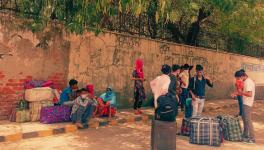Drug Menace: The Biggest Challenge Before the New AAP Govt in Punjab
Recently, Bhagwant Mann, Punjab’s new Chief Minister, held his first meeting with senior police and administrative officials over the drug menace in the state. He said that officials were to ensure that the police would take swift and stringent action in any drug-related matter. The police officials will be considered accountable if any drug supply occurs in their respective areas. He also pointed out that the drug users would be rehabilitated in hospitals, and the services of those who became sober would be utilised to motivate other victims to leave drug usage.
Harpreet Singh Sidhu, Additional Director General of Police in Punjab, said, “To combat the menace of drug abuse in the state, the Government of Punjab constituted a Special Task Force (STF) way back in 2017. Its main objectives are to effectively implement laws against drug trafficking, which would result in apprehending drug traffickers and disrupt the supply chain, develop and coordinate de-addiction programs to recover victims of drug abuse and prevent the general public from falling prey to drug abuse.”
As per the data provided by Sidhu, record heroin seizures of about 759 kg were made in 2020, which was the largest ever for any single year in Punjab to date. Heroin recoveries have jumped 3.6 times (363%) since 2017. Over 558 Big drug traffickers (2 kg & above heroin recovery) were arrested. Over 108 police personnel have been dismissed from service for their involvement in drug-related offences from 2017 to 2022. 6704 Commercial Quantity cases were registered under the Narcotics and Psychotropic Substances (NDPS) Act, and 11,647 persons were arrested.
Property of drug traffickers’ worth about Rs 240 crores was forfeited from 2019 to 2021. In 2021, Rs. 5.63 crores of drug proceeds was recovered from drug traffickers/peddlers. And conviction rate in NDPS Act cases has increased from 59% in 2018 to 64% in 2019 and 66% in 2020, and 79% in 2021.
“In order to not allow new addicts to add to the existing numbers and vulnerable sections of the society, the prevention strategies of STF also focussed on generating a mass movement among the public and introducing the program of Drug Abuse Prevention Officers (DAPO) where local people help in motivating the addict to avail treatment and, another Buddy Program where students aim to gain adequate knowledge and skills to protect himself/herself as well as the buddy group from falling prey to drug abuse as catalysts for this purpose,” Sidhu said.
However, the experts are of the view that there is a lot more to be done on the ground in order to eradicate the social and health evil of drugs from the state.
Shashi Kant, former DGP Punjab - who dared to expose drug rackets, the nexus of politicians (reigning as well as in opposition), bureaucrats and the drug mafia during his service - continues to assist the Punjab and Haryana High Court in prominent drug-related cases after his retirement. His Twitter handle says that he is a vociferous anti-drug activist, proudly controversial and dislikes most politicians.
“Drugs eradication was one of the electoral issues in the state Assembly election, but we are yet to see any significant steps taken by the new government in this direction." He said the matter has come to such a state where police, instead of working to curb the drugs, were found supplying drugs from police stations in many cases. The drug trade would not have prospered in the state without the connivance of politicians and officials, he said.
Kant took us back to the history and genesis of the drug trade in the state.
“Punjab and West Coast of Bombay would be the route for smuggling of gold which would come from countries like Pakistan and Dubai in the distant past. Amritsar town of Punjab still has one prominent gold market known as Guru Bazaar. When gold prices plummeted and stabilised, the focus shifted to the smuggling of heroin (an opioid). It was halted midway during the reformist movement stirred by (militant) Jarnail Singh Bhindranwale around 1977 when he dictated to the Sikh community to shun liquor or drugs in any form.”
He added, “However when militancy shifted to another tangent of violence beyond the reform movement and the militancy era ended, heroin took in a big way. People who were prohibited now desired some kind of intoxicants. There were all sorts of reasons like peer pressure, joblessness, instability etc., for them to look for these substances.”
He said that the same wealthy and influential local people who were earlier dealing with gold have now moved to drug smuggling. The neighbouring countries involved in one supply route were Afghanistan, Pakistan and Iran, and another was a golden triangle of Burma, Lao and Cambodia. They were sending out 50% of the drug supply to the USA and the rest to Europe through Punjab. In the supply process, locals started getting the drug and becoming addicted.
"I remembered as the head of an intelligence unit in Punjab police in 1987, and I was handed over the task to dig deeper into drug trade by the State government as there was hardly any information about it at that time and, a few incidents of drug involvement surfaced here and there. When I started collating data, I was surprised to know the racket had spread out considerably. I prepared extensive documentation,” he said.
Kant added, “Much later, these same documents were reported missing by the information commissioner office when Punjab and Haryana High Court sought it by taking suo notice at his petition in 2013. The documents mentioned the name and role of those who belonged to various influential strata in society and were thickly involved in this nefarious game," said Kant.
“As an advisor in the Trilok Singh v/s State of Punjab case, where prisoner Trilok Singh alleged that drugs were supplied in prison houses, I gave my opinion to the court was that until drug supply was not contained in an open society, it cannot be barred from being accessible into the prisons,” Kant recalls.
Mintoo Gursaria, 45, a radio news analyst and author of several books in Punjabi on drugs in Punjab, got out of drug addiction after being in its throes for more than a decade. Now he voluntarily helps the addicts to rid of addiction also. "I became an addict at a young age in the 1990s under peer pressure. I could see that time; the youth in Punjab would feel demoralised due to a long period of hopelessness emanated from militancy and then instability afterwards. All the recruitment in the government jobs had come to a nought for a few years after militancy which led to unemployment. Lots of people took to drugs during that phase,” he told NewsClick.
Manjit Singh, a retired professor in social sciences and a prominent social activist, finds a causal factor in the inherent flamboyant nature of a significant chunk of people in the community. “Thanks to the good climate, alluvial soil and five rivers which flow through it, people of Punjab gained considerable prosperity from flourishing agriculture. Besides that, the trend of youngsters moving overseas and sending good money back home also added to the opulence. As Punjabi people are known for merrymaking and their flamboyant lifestyle, so many fell into the trap of drugs for instant joy as they could afford to buy this expensive commodity.”
All the experts agree that this deep-rooted miasma is challenging to curb in the state, as the nexus of politicians, bureaucrats, and drug mafia make massive money out of it. Hence they do not let it come to an end.
Pyara Lal Garg, retired professor in medicine and social activist who helped jail inmates who are addicts to break their stubborn addiction, shows a ray of hope by saying, "It is only if local people show determination and form their committees at the village level, empowered to fight drug supply, then after a few bouts of resistance such as violence by mafia or fake cases by police, the drug problem may come to an end in the state gradually.”
The writer is a freelance journalist.
Get the latest reports & analysis with people's perspective on Protests, movements & deep analytical videos, discussions of the current affairs in your Telegram app. Subscribe to NewsClick's Telegram channel & get Real-Time updates on stories, as they get published on our website.
























